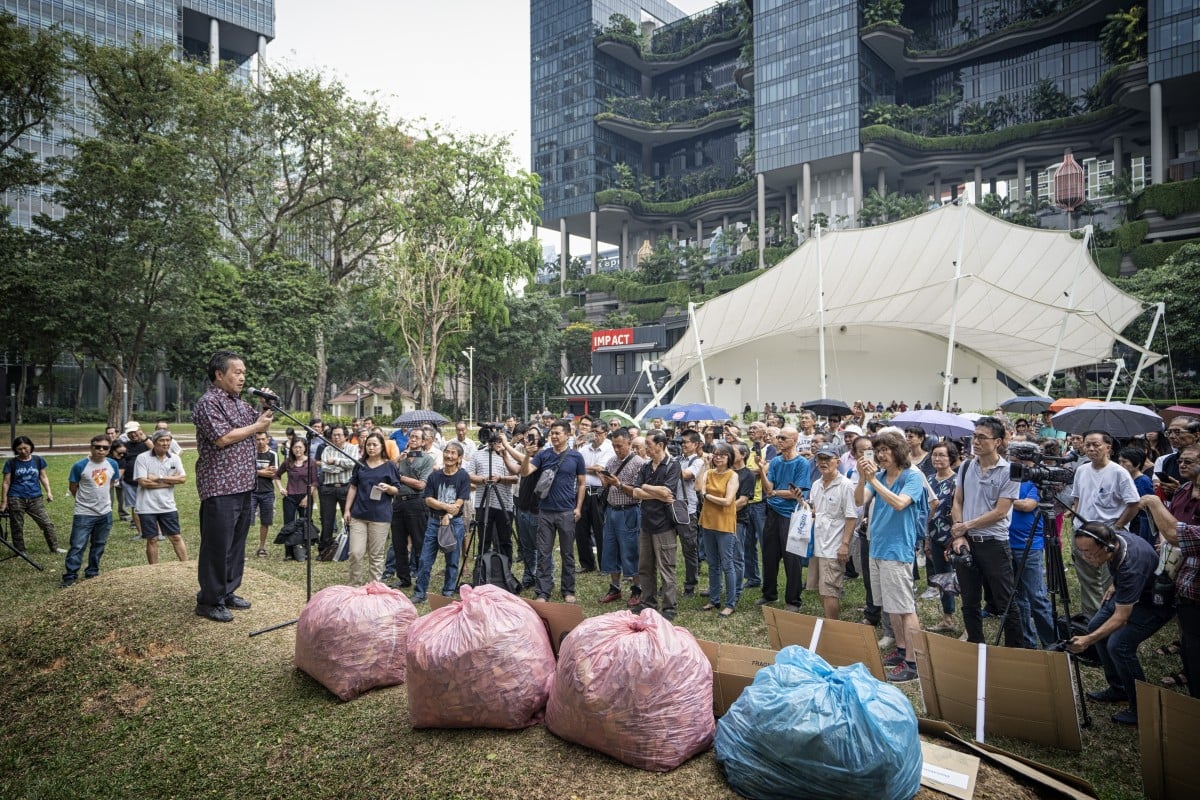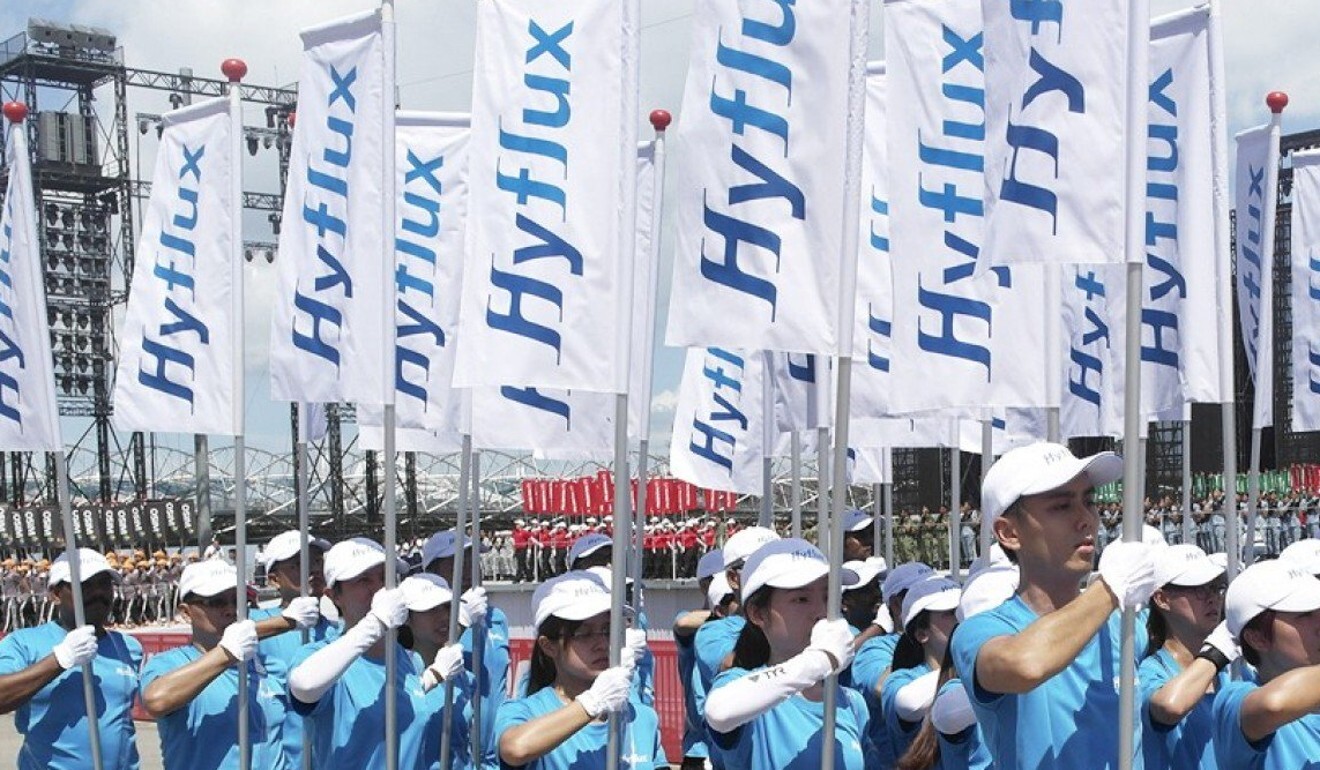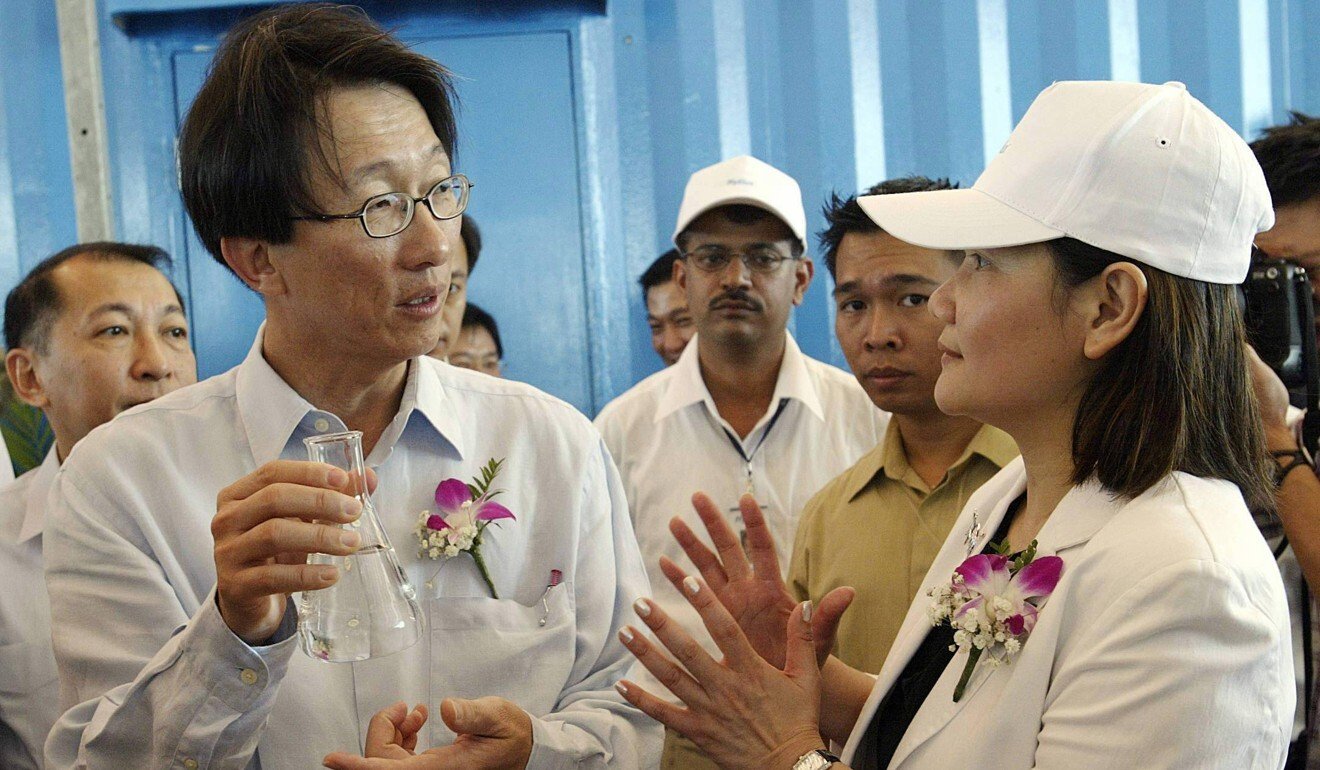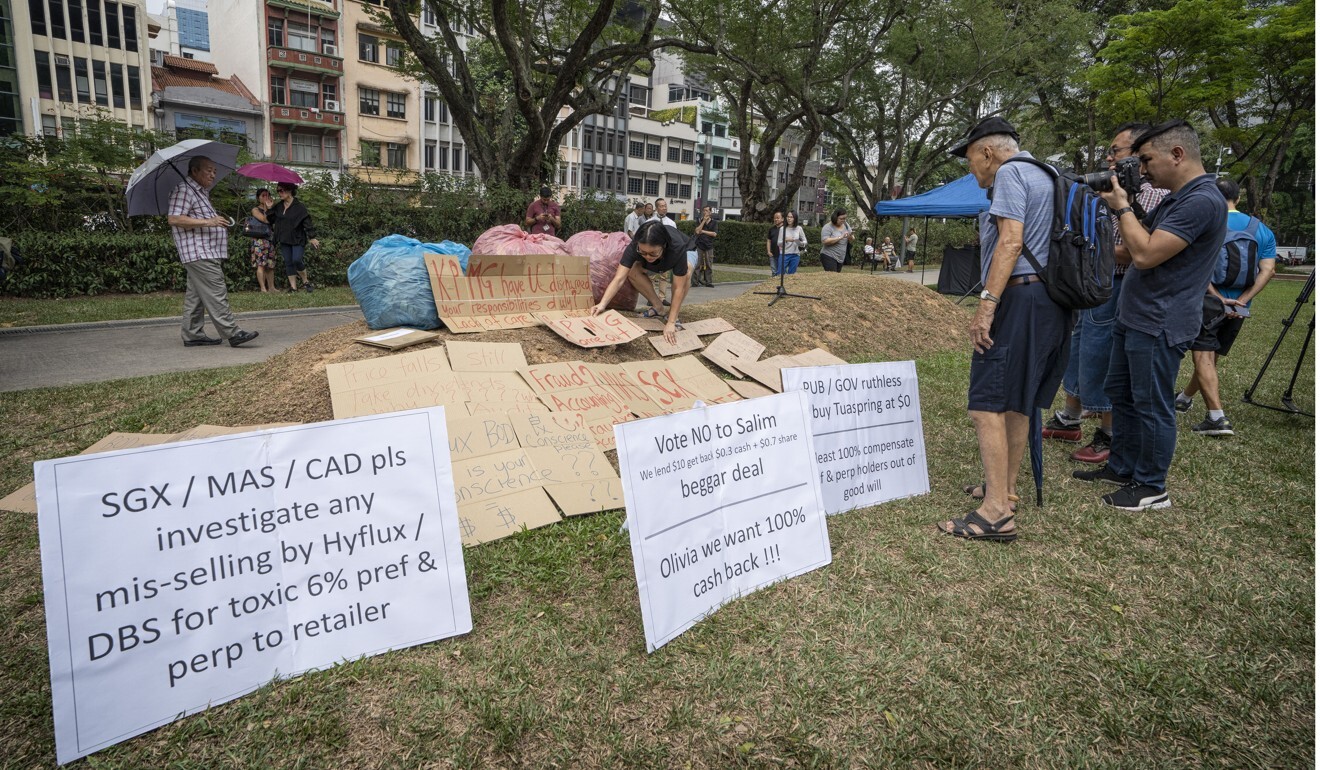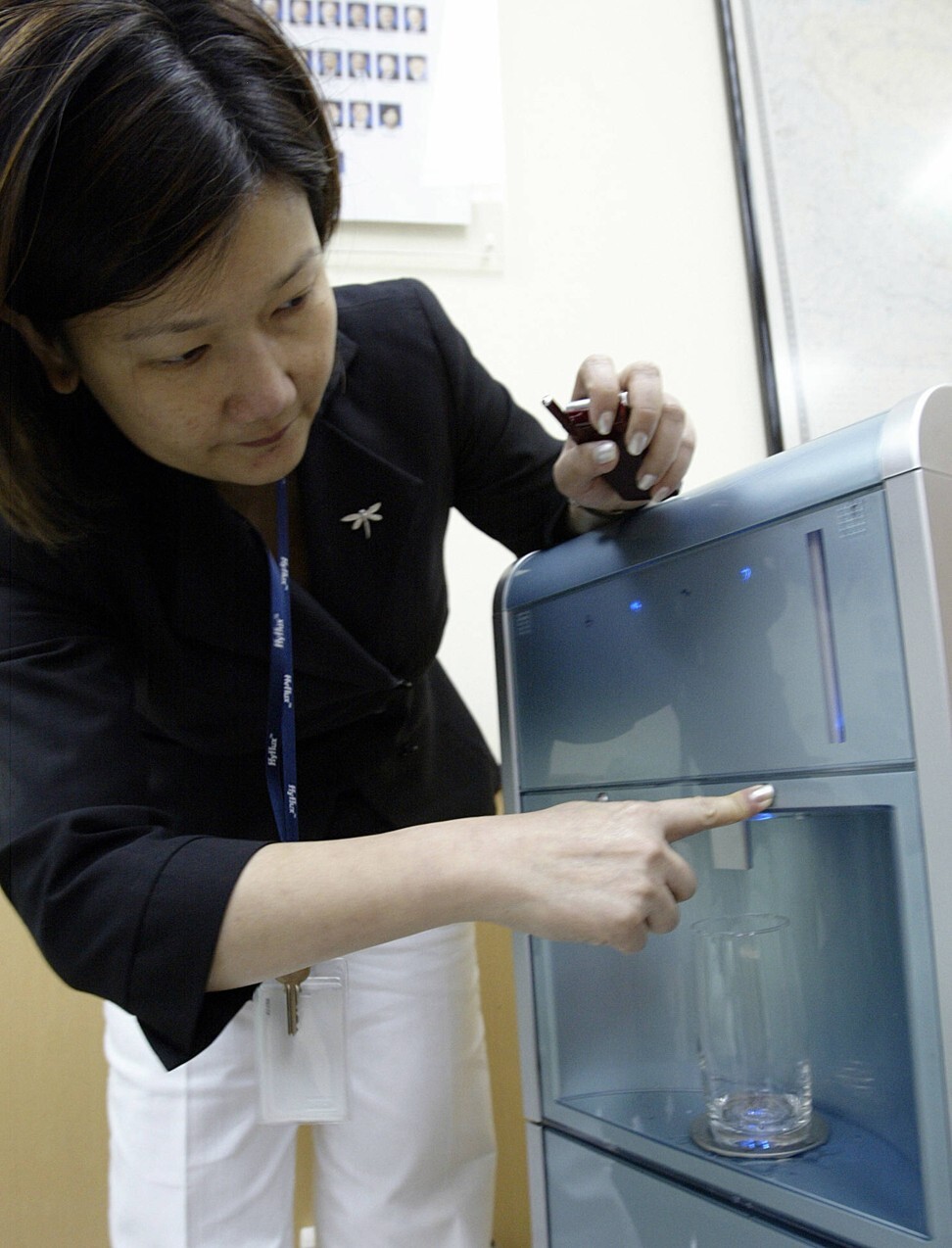How Singapore’s corporate darling Hyflux and founder Olivia Lum fell from grace
- The firm put Singapore on the map as a water treatment innovator and made its founder rich; now it owes billions and is staving off bankruptcy
- The fiasco has become a case study for corporate governance gaps in Singapore – but was it all just a case of a ‘basic mistake’?

Kok Xinghui in Singapore
Published: 11:03am, 14 Nov, 2020
Investors gather in Singapore’s Speaker’s Corner to protest against Hyflux’s debt restructuring plan. Photo: Bloomberg
In 2001, Hyflux – with Hydrochem as its wholly-owned subsidiary – became the first water treatment company to be listed in
Singapore
. It was a big deal. The company was founded locally in 1989 by Olivia Lum, then just 28, who left her chemist job to strike out on her own with one clerk and one technician. By the time Hyflux listed, the S$20,000 (US$15,000) she started the company with had multiplied to around S$70 million.
And for a long time, Hyflux was a corporate darling in the city state.
It developed the membrane
technology
that paved the way for the country to begin recycling water and in turn put it on the map as a global hub for innovation in water management and treatment.
Lum became a Nominated Member of Parliament and a poster child for innovation and entrepreneurship. She became
Her World magazine’s Woman Of The Year in 2003, was worth hundreds of millions of dollars, and ranked in various Forbes’ lists.
Hyflux CEO Olivia Lum. Photo: AFP
But in May 2018, Hyflux surprised the world when it called for a halt on trading, and four days later, said it had applied to the Singapore High Court to begin reorganising its liabilities and businesses. By then, it already had a global presence and employed more than 2,500 people.
Its liabilities added up to a whopping S$2.95 billion. Under a new law to deal with corporate insolvencies and restructuring, 19 banks banded together as an unsecured working group (UWG) holding more than US$931 million of debt; another S$900 million is owed to 34,000 retail investors, who are mostly based in Singapore, holding Hyflux’s perpetual and preference shares (PnPs). These shares trade on the Singapore stock exchange and it is up to the company when to redeem this from the investors.
Japan will profit from Singapore’s taste for sewage. Hong Kong dig in!
31 Aug 2020

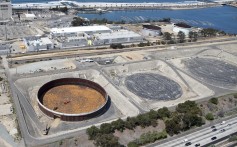
The UWG sought a judicial manager while the company, by then under bankruptcy protection, sought to cobble together a restructuring plan. Yet two and a half years later and with 12 extensions to the debt moratorium, the seven-member board has not offered creditors a clear path forward. Stakeholders are losing patience. The court hearing for the UWG’s judicial manager has been postponed multiple times after the company presented an array of potential bidders. The next court date is November 16.
https://www.scmp.com/week-asia/poli...ng-time-water-dispute-malaysia-daim-zainuddin
Retail investors such as teacher Paul Lim, 40, are suspicious that Hyflux is using the prospect of suitors to extend their court protection. Investors like him had bought into Hyflux, believing the Singapore government would not let it fail. Said Lim, who bought S$37,000 worth of PnPs, said: “Notice how they reveal new suitors whenever a court date is near.”
Lawrence Loh, an associate professor of business administration at the National University of Singapore (NUS), said: “The fabled white knight that comes in shining armour and rescues the company doesn’t seem to happen. Even with what’s on the plate now, and there are still many potential white knights, I don’t think Hyflux will hit anything big.”
Hyflux employees in Singapore. Photo: Hyflux
If Hyflux is put under judicial management, the 34,000 retail investors are likely to bid adieu to their S$900 million because of their low pecking order as claimants. The only hope for PnP holders lies in deals promising a pro-rata share.
Mak Yuen Teen, an associate professor of accounting at NUS Business School and corporate governance expert, said: “Whatever the deal, we would expect deep haircuts or near total losses for junior claims.”
A ‘BASIC’ MISTAKE
How did a corporate darling fall so far from grace? To Nitin Pangarkar, an associate professor looking at business policy at NUS, it was simply “a basic mistake”.
In 2010, Hyflux had put in the most competitive bid for Singapore’s biggest desalination plant – Tuaspring Integrated Water and Power Project – offering to supply water at a first-year price of S$0.45 per cubic metre compared to other offers of S$0.67 and S$1.42 per cubic metre. The project cost was stated at S$890 million, and Hyflux added on a power plant so it could generate what it needed for the desalination process and sell excess power to the power grid.
By the time the plant was operational in 2016, though, the energy market had liberalised with competitors coming on board, creating a massive overcapacity that depressed energy prices.
Meanwhile, Hyflux issued PnPs and took on loans worth hundreds of millions of dollars. The project cost of Tuaspring was also revised upwards to S$1.05 billion.
Hyflux had taken on too much debt, said Pangarkar, and in the power generation sector which was outside its core business of water treatment. He said other mistakes were basing the water price on the price of electricity from its power plant, and not considering the impact of new competitors.
“Prices in power generation proved to be volatile,” he said. In fact, wholesale electricity prices in 2018 cleared at levels below fuel costs.
Olivia Lum, Hyflux founder, talks to then Minister for Environment Lim Swee Say at the ground breaking ceremony for Singapore's first seawater purification plant in 2004. Photo: AFP
So losses continued to mount in the first three months of 2018 and reached S$22.2 million. At the same time, Hyflux’s debts came calling. The water treatment firm had a coupon payment due May 28 on its S$500 million of 6 per cent perpetual securities, it also had another S$100 million of 4.25 per cent bonds maturing that September.
To Loh, Hyflux had “bitten off more than it can chew”.
He said it came down to corporate management and risk management. “They moved into an area of business they were not familiar with and funded that with a fairly risky capital strategy which is debt, so it’s a double whammy. Of course this is in hindsight, but the board probably didn’t take the necessary due diligence in the risk assessment and business evaluation.”
Lum has come under scrutiny for receiving between S$750,000 and S$1 million in salary, benefits and bonuses despite Hyflux reporting losses in 2017. The Securities Investors’ Association (Singapore) (SIAS) singled her out for, on top of her “large remuneration”, getting more than S$60 million in dividends “in the time that shareholders and bondholders have seen their entire investment destroyed”.
Hyflux and Lum declined to speak to
This Week in Asia. But last year, while talking about a possible takeover of Hyflux in a townhall session with creditors, Lum said: “I know many people do not like to see my face anymore.
I’m okay. I’m prepared to step down.”
Lum is still executive chairman and group chief executive officer of Hyflux. One independent director fell out with the board and resigned and the other members remain unchanged.
WHAT WENT WRONG
While the government took over the operations of the loss-making Tuaspring desalination plant without seeking compensation, alleviating pressure on Hyflux, it made clear last year it would not use taxpayers money to help the company or investors recoup their losses.
Loh said he was surprised Hyflux’s last chance saloon offered by the courts had gone on for so long.
“In my memory, I haven’t seen a case that dragged so long in terms of a moratorium,” said Loh.
Even the Court appeared frustrated. Talking about the repeated extensions without better progress shown in closing a restructuring deal, Justice Aedit Abdullah who on October 14 granted Hyflux its “last” extension, said: “Suspicion is building up considerably whether there is some sort of gamesmanship going on here.”
Signs at a protest over Hyflux’s debt restructuring plan in Singapore’s Speaker’s Corner. Photo: Bloomberg
Loh estimates about seven parties were interested in a restructuring deal with Hyflux. The experts say there are a few offers still on the table but it is unlikely Hyflux’s board would take any up before the next court date.
American fund manager Strategic Growth Investments (SGI) is among those that have made offers. It proposed to invest at least S$204.8 million, with senior unsecured creditors getting S$97 million, trade creditors S$15.8 million and the PnP investors S$32 million – all on a pro-rata basis.
Aqua Munda, described as “rather mysterious” by Mak as no one knows much about this suitor, is proposing to buy up the debts. The other two offers are from Middle Eastern utility firm Utico, which has made the biggest offer at S$486 million; and Pison, the investment vehicle of Indonesian magnate Johnny Widjaja, which set aside S$200 million for a “reverse Dutch auction” where potential sellers make the bid rather than the buyer.


To Loh, it was hard for Hyflux to accept these deals because there was a “big mismatch” between the offers and the company’s debts.
Mak said the issue was getting the support of all the different stakeholders who have different interests, and those interests also differ from those of the board which is leading the restructuring effort.
Mak said: “The board would prefer deals that release them from any potential liabilities. The proposed Utico deal would not do that, and a judicial manager may well take action against the directors if there are breaches of duties.”
Even the retail investors who rank as junior claimants could exert pressure on Hyflux because they were “always in limelight”, added Loh.
Mak said the restructuring “might have had a chance” if most of the existing board members had stepped down at the beginning so there would have been “a fresh slate of truly independent directors” with no skin in the game. “But then, that was also unlikely to happen because a new truly independent board may also take action against the former directors if there are potential breaches,” he added.
Olivia Lum, founder of Hyflux, operates an appliance that can extract moisture from the air and turn it into drinking water at her office in Singapore. Photo: AFP
A PANDORA’S BOX OF NEW POSSIBILITIES?
Loh and Mak see judicial management as the preferred outcome.
Loh said: “I think it is good to have a rapid resolution. I don’t think it is meaningful to drag on while the value of Hyflux is depreciating. November 16 is the thin red line that must be crossed. We’ve already given the company such a long time to address this.”
Mak said this was “the best solution”. He said the judicial manager could “objectively evaluate the deals on the table and reboot the restructuring process”.
Both agree that it does not mean Hyflux will automatically go into liquidation. Loh said the judicial manager could revisit the deals or come to a hybrid solution, liquidating some assets and restructuring others. “The only certainty is the board will not continue to have a say,” he said.
The judicial manager would have six months to restructure and could apply for extensions, said Mak, though it would have to keep the court updated. It could also investigate wrongdoings or potential breaches of duties and sue the directors, he added.
Of course, “the longer this drags on, more resources will be spent, and the likelihood of a liquidation increases”, said Mak.
Having Hyflux go under judicial management also meant legal processes such as civil suits and criminal proceedings could go ahead, said Loh.
This is an outcome retail investors are hoping for. Lim, the teacher who invested S$37,000 in PnPs, wants this to happen so independent third parties can “dig out evidence of their non-disclosures and that they already knew Hyflux was insolvent when they sold S$500 million PnPs to the public”.
Another investor, an investment specialist who works in a private bank but asked to not be named, hopes the outcome of the investigations will ensure a Singapore bank that issued the PnPs is held accountable for its role.
“The bank has to do due diligence … The banks need to ask hard questions, stress test financial models and business plans to make sure the company can repay their debts in a variety of scenarios, not just take in the case the company is presenting to them.”
Loh said: “It’s not going to be the end point. In fact, it’s going to open a Pandora’s box of new possibilities.”


